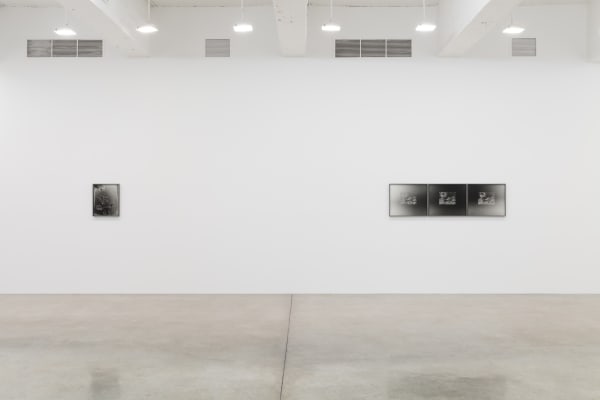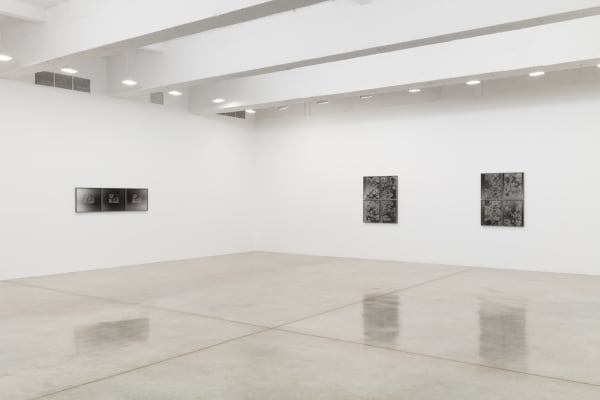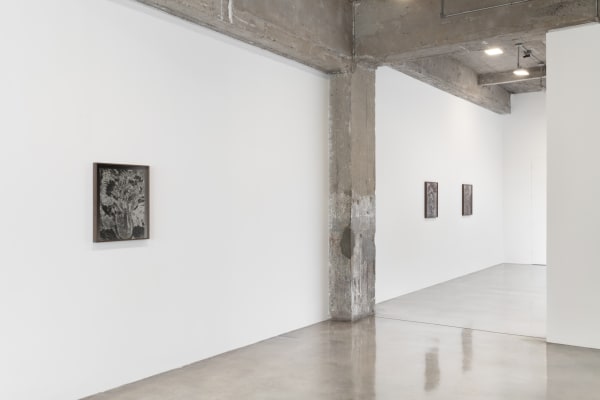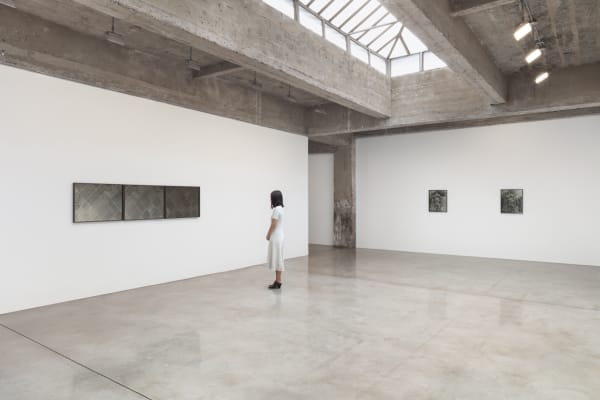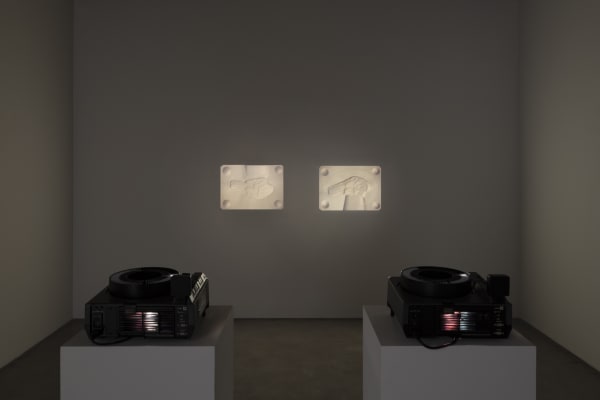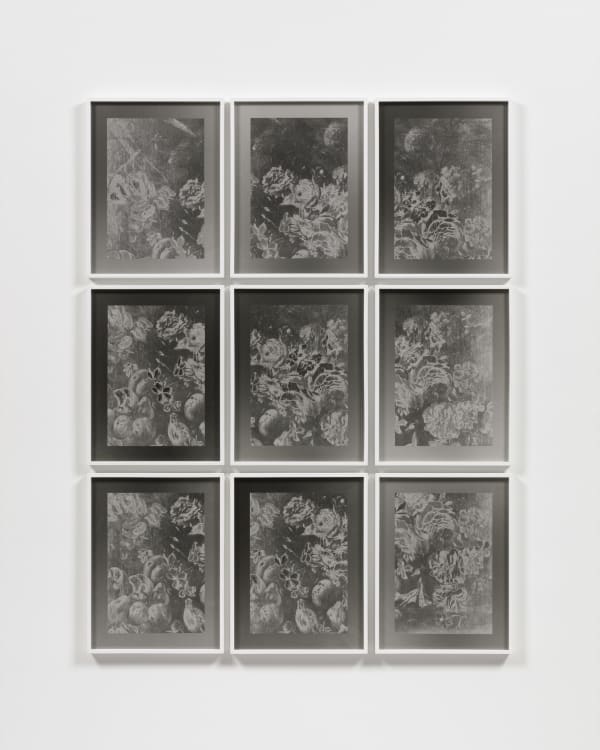Lisa Oppenheim: Spolia: Tanya Bonakdar Gallery, New York
Tanya Bonakdar Gallery is pleased to present Spolia, an exhibition of new work by Lisa Oppenheim, on view from September 7 through October 22, 2022. This is the artist’s fourth solo show at the gallery.
Spolia, the Latin word for “spoils,” refers to architectural fragments taken out of their original contexts and reused elsewhere. There is a violence connoted by the word, of plundering and pillaging during wartime, but also something potentially generative: the same spoils used as the literal building blocks to create new structures. In this exhibition, Oppenheim uses the Nazis’ own documentation of their looting as the building blocks for all the works. She does not attempt to recreate or recuperate what was lost, but rather makes new artworks out of the images and fragments of information that remain.
Oppenheim often begins a project by thinking about how to represent what no longer exists or is otherwise hidden, a punched out hole in a Walker Evans photograph, the material and colonial histories of photographic substrates. These absences allow her to think through particular histories and materials to produce artworks that are constitutive of both. For this show, Oppenheim produces work from a place that is both rooted in personal history (her mother’s family has a long tradition of cultural and political advocacy, particularly in issues related to Jewish communities) and pressing issues of the moment when questions of restitution of cultural objects are at the forefront of much discussion and institutional prioritization.
Ever bureaucratic, the Nazis kept careful records of their crimes and much documentary evidence has survived, including photographs, ledgers, and detailed inventory cards. The ERR Project (named after The Einsatzstab Reichsleiter Rosenberg, a “special task force”charged with seizing valuable Jewish and other cultural properties in occupied countries), an international effort involving both museums and government archives, has built an extensive database of art objects that passed through the Jeu de Paume, while the Free University in Berlin maintains a similar database documenting those artworks seized from German institutions in the early years of the Nazi regime as “degenerate art.”
Oppenheim scoured these archives for images of artworks that had been stolen but never restituted and whose whereabouts remain unknown. Many of these works are thought to have been destroyed, while others might still circulate in the murkier corners of the art market. Oppenheim gravitated to the genre of the still life, both because of its prevalence and because of the intimate, domestic nature of such paintings.
One such painting, Miroir entouré d'oiseaux, is the point of departure for Oppenheim’s large work occupying most of the ground floor gallery. She commissioned a photographer to photograph the sky above 38 Avenue Henri Martin in Paris, the former home of the Adolphe Schloss family from whom the painting was stolen. These are printed in negative at the size of the lost painting, connoting both the smoke into which this painting seemingly disappeared, and the flame Oppenheim uses to produce the solarized fragments of a photograph taken by the ERR. Other works in the show similarly use the smoke technique. Oppenheim produces all these images in the darkroom through traditional photographic techniques and then solarizes the prints with firelight, inverting some of the positive and negative components of the image and collapsing the binary positive and negative logic of traditional photography.
This positive/negative relationship also informs the synchronized 35mm slide projection Kakadu. The Nazis, above almost all else, prized the medium of porcelain, especially porcelain made from German clay because of its absolute whiteness and source in German earth. There are hundreds of unrestituted figurines and other porcelain objects listed in the ERR’s records of looted goods. Some of the most precious originated in the workshops of Meissen, the oldest porcelain manufacturer in Europe. Meissen maintains a vast archive containing the molds of nearly everything the company has produced since its founding in 1710. Ceramic molds, like photographic negatives, can produce many positive objects. Based only on a written description of a stolen figurine of a porcelain cockatoo in the ERR records, Oppenheim worked with the archivists at Meissen, who were able to locate the molds used to create it. However, in the absence of the figurine, here the molds themselves become the objects.
Another work in the show, Stola, is based on an object in Oppenheim’s personal collection, an antique lace scarf with geometric patterns in beaded silver that she bought in a flea market in Paris. In the ERR records, she came across a description of such a scarf, also originating in Paris. It was repatriated to France after the war but never restituted. Could this be the same object? Probably not, but it points to the question of the provenance of any historical object purchased in any flea market or on ebay or etsy. Where did that vintage armoire once reside? That lace tablecloth? What are the histories of the objects around us and what can they tell us? Oppenheim used the scarf itself as a photographic negative, producing an index of the object so its form is rendered in light. In the developing process, she replaced the silver gelatin in the photographic emulsion with metallic silver, conjuring the scarf’s beads out of the paper itself.
Oppenheim was born in 1975 in New York City, where she currently lives and works. She received her BA from Brown University in 1998, and later an MFA from the Milton Avery Graduate School for the Arts at Bard College in 2001. She also attended the Whitney Independent Study Program and the Rijksakademie van beeldende kunsten in Amsterdam.
Oppenheim has been the subject of solo exhibitions at MOCA Cleveland (2017), the FRAC Champagne-Ardenne (2015), Kunstverein in Hamburg (2014), Grazer Kunstverein (2014) and notable group exhibitions including the forthcoming Braided Histories: Modernist Abstraction and Woven Forms (working title), National Gallery of Art, Washington, D.C. (will travel to Los Angeles County Museum of Art and National Gallery of Canada, Ottawa); Afterlives, The Jewish Museum, New York (2021); Off the Record, Guggenheim Museum, New York (2021); Light, Paper, Process: Reinventing Photography, The Getty Center, Los Angeles (2015); Photo-Poetics,Deutsche Bank Kunsthalle, Berlin and Guggenheim Museum, New York (2015); and New Photography at The Museum of Modern Art (2013).
Her work is held in the permanent collections of the Museum of Modern Art, New York, The Solomon R. Guggenheim Museum, New York, The J. Paul Getty Museum, Los Angeles, Israel Museum, Jerusalem, Stedelijk Museum Amsterdam, Victoria & Albert Museum, London, MIT List Visual Arts Center, Cambridge, and Milwaukee Art Museum, among others.
All installation images above: Photo by Pierre Le Hors
-
 Lisa Oppenheim, Stilleben I, (1942/2021), 2021
Lisa Oppenheim, Stilleben I, (1942/2021), 2021 -
 Lisa Oppenheim, Nature Mort, 1943/2022 (Version I), 2022
Lisa Oppenheim, Nature Mort, 1943/2022 (Version I), 2022 -
 Lisa Oppenheim, Miroir entouré d’oiseaux, 1943/2022, 2022
Lisa Oppenheim, Miroir entouré d’oiseaux, 1943/2022, 2022 -
 Lisa Oppenheim, Stilleben mit Früchten, totem Geflügel, Gemüse und Meerschweinchen, 1942/2022, 2022
Lisa Oppenheim, Stilleben mit Früchten, totem Geflügel, Gemüse und Meerschweinchen, 1942/2022, 2022 -
 Lisa Oppenheim, Entartete Kunst, Märchen, 1937/2022 (Version I), 2022
Lisa Oppenheim, Entartete Kunst, Märchen, 1937/2022 (Version I), 2022 -
 Lisa Oppenheim, Blumenstilleben, N.D./2022 (Version I), 2022
Lisa Oppenheim, Blumenstilleben, N.D./2022 (Version I), 2022 -
 Lisa Oppenheim, Entartete Kunst, Alpenlandschaft, 1937/2022 (Version II), 2022
Lisa Oppenheim, Entartete Kunst, Alpenlandschaft, 1937/2022 (Version II), 2022 -
 Lisa Oppenheim, Stola , 2022
Lisa Oppenheim, Stola , 2022
Lisa Oppenheim in conversation with Bettina Steinbrügge about Lisa's exhibition "Spolia" at Tanya Bonakdar Gallery, New York, 2022.



